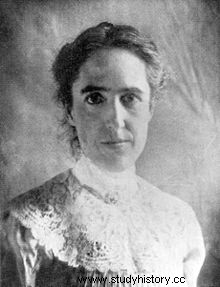Henrietta Swan Leavitt (1868 – 1921) was an American astronomer. His important discovery about the periodic brightness variations of Cepheid stars has allowed astronomers to measure great distances in the universe, including those separating the Earth from very distant galaxies.
The “Harvard Computers”, “human computers”
 Born July 4, 1868 in Massachusetts, Henrietta Swan Leavitt is the daughter of Henrietta Swan Kendrick and George Roswell Leavitt, the pastor of a Congregational church. Henrietta was educated at Oberlin College (Ohio) and in 1892 graduated from the Society for the Collegiate Instruction for Women (Radcliffe College, Massachusetts). During her fourth year at university, she chose an astronomy course, in which she proved to be brilliant.
Born July 4, 1868 in Massachusetts, Henrietta Swan Leavitt is the daughter of Henrietta Swan Kendrick and George Roswell Leavitt, the pastor of a Congregational church. Henrietta was educated at Oberlin College (Ohio) and in 1892 graduated from the Society for the Collegiate Instruction for Women (Radcliffe College, Massachusetts). During her fourth year at university, she chose an astronomy course, in which she proved to be brilliant.
In 1893, Edward Charles Pickering, director of the Harvard College Observatory, decided to recruit “Harvard Computers” (“calculators” or “human computers”) to mathematically process astronomical data. He chose women, probably because they were paid less than the men. Henrietta was hired in 1893, alongside Williamina Fleming, Annie Jump Cannon and Antonia Maury. Examining photographic plates taken at different periods, she must measure and catalog the luminosity of stars to determine their constancy or variability.
The Cepheids
Henrietta Swan Leavitt does a phenomenal job and examines thousands of variable stars in the Magellanic Clouds. In 1908, she published her results in the Annals of the Astronomical Observatory of Harvard College . She notes that some of these stars, the Cepheids, show periodic variations in luminosity. In 1912, she added that the luminosity of these stars is linked to their period. This very important property allows astronomers, thanks to the absolute and apparent luminosity of stars, to develop a scale of the distances of the Universe by measuring the distance between the Earth and very distant galaxies. The year after Henrietta's discovery, Danish astronomer Ejnar Hertzsprung determined the remoteness of several Cepheids from the Milky Way.
No Nobel Prize
Henrietta Swan Leavitt continued her work despite family obligations and frequent health problems; an illness affects her hearing and makes her increasingly deaf. In 1921, she was appointed head of stellar photometry. On December 12, 1921, Henrietta Swan Leavitt died of cancer at the age of 53.
The asteroid (5383) Leavitt and one of the moon's craters were named in his honor. In 1924, the Swedish mathematician Gösta Mittag-Leffler, unaware of her death, tried to nominate her for the Nobel Prize, but in vain:one cannot receive the Nobel Prize posthumously. Astronomer Edwin Hubble, whose discovery of the expansion of the universe was made possible by the work of Henrietta, himself often said that she would have deserved the Nobel Prize.
